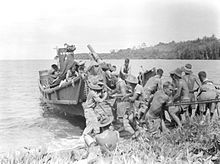2/5th Field Regiment
| 2/5th Field Regiment | |
|---|---|
 Members of the 2/5th Field Regiment unloading a 25 Pounder at Buna | |
| Active | 1940–1946 |
| Country | Australia |
| Branch | Australian Military Forces |
| Type | Regiment |
| Role | Artillery |
| Part of | 7th Division |
| Engagements | World War II |
| Insignia | |
Unit colour patch |  |
The 2/5th Field Regiment was an
History
The 2/5th Field Regiment was formed in May 1940, as part of the all volunteer
In June 1941, the regiment was committed to the

The campaign concluded in mid-July with an armistice, after which the regiment undertook occupation duties for the remainder of 1941. During this time, the 2/5th detached one battery to
In August 1942, the regiment's first battery, the 9th, deployed to Milne Bay in support of the 18th Brigade, as Japanese forces advanced along the Kokoda Track towards Port Moresby. They subsequently took part in the Battle of Milne Bay, while the rest of the regiment was preparing for deployment around Woodford, arriving in October. The 55th Battery subsequently took part in the capture of Buna, being moved by sea from Oro Bay aboard several luggers. During the move, the vessels were attacked and two guns were lost, as well as several personnel killed.[9] They subsequently supported the 18th Brigade and US 32nd Infantry Division. Meanwhile, the 10th Battery undertook defensive duties around Porlock Harbour and on Goodenough Island. The regiment's batteries were progressively relieved between February and April 1943, after which it concentrated around Port Moresby, remaining there until January 1944, when they returned to Brisbane having spent the remainder of its time in New Guinea carrying out garrison duties.[10]
A period of leave followed for the regiment's personnel, after which they rejoined the unit at
Following the war, the regiment's personnel were
Commanders
The following officers commanded the 2/5th Field Regiment during the war:[18][19]
- Lieutenant Colonel Lloyd Ingate (1940–1941)
- Lieutenant Colonel John William Alexander O'Brien(1941–1942)
- Lieutenant Colonel William Courtney (1942–1944)
- Lieutenant Colonel Frank Richardson (1944–1945)
References
Citations
- ^ McKenzie-Smith 2018a, p. 3065.
- ^ a b c d e McKenzie-Smith 2018a, p. 3066.
- ^ Horner 1995, p. 226.
- ^ Horner 1995, p. 275.
- ^ Horner 1995, p. 276.
- ^ McKenzie-Smith 2018b, p. 2085.
- ^ "No. 35360". The London Gazette (Supplement). 25 November 1941. p. 6825.
- ^ Johnston 2005a, p. 77.
- ^ Horner 1995, p. 344.
- ^ McKenzie-Smith 2018a, pp. 3066–3067.
- ^ a b c McKenzie-Smith 2018a, p. 3067.
- ^ Johnston 2005b, p. 14.
- ^ Horner 1995, p. 418.
- ^ Keogh 1965, p. 463.
- ^ a b O'Brien 1950, p. 243.
- ^ "Chapter 1 Order of Battle – Army: Section 2: The 7th Australian Division". Consolidated Library of Information and Knowledge. Department of Veterans' Affairs. Archived from the original on 24 July 2018. Retrieved 24 July 2018.
- ^ Johnston 2005a, pp. 248 & 253.
- ^ "2/5th Field Regiment: Appointments". Orders of Battle. Retrieved 23 July 2018.
- ^ Johnston 2005a, p. xx.
Bibliography
- ISBN 1-86373-917-3.
- ISBN 1-74114-191-5.
- Johnston, Mark (2005b). The Huon Peninsula 1943–1944. Australians in the Pacific War. Canberra: Department of Veterans' Affairs. ISBN 1-920720-55-3.
- OCLC 7185705.
- ISBN 978-1-925675-146.
- McKenzie-Smith, Graham (2018b). The Unit Guide: The Australian Army 1939–1945, Volume 2. Warriewood, New South Wales: Big Sky Publishing. ISBN 978-1-925675-146.
- OCLC 557458425.
